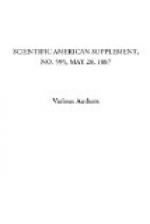Similar events were noticed during the epidemic of 1833:
“On April 3, 1833, the very day on which I saw the first two cases that I did see of influenza—all London being smitten with it on that and the following day—the Stag was coming up the Channel, and arrived at two o’clock off Berry Head on the coast of Devonshire, all on board being at that time well. In half an hour afterward, the breeze being easterly and blowing off the land, 40 men were down with the influenza, by six o’clock the number was increased to 60, and by two o’clock the next day to 160. On the self-same evening a regiment on duty at Portsmouth was in a perfectly healthy state, but by the next morning so many of the soldiers of the regiment were affected by the influenza that the garrison duty could not be performed by it.”
After reviewing the various hypotheses which had been put forward to account for the disease, sudden thaws, fogs, particular winds, swarms of insects, electrical conditions, ozone, Sir Thomas Watson goes on to say:
“Another hypothesis, more fanciful perhaps at first sight than these, yet quite as easily accommodated to the known facts of the distemper, attributes it to the presence of innumerable minute substances, endowed with vegetable or with animal life, and developed in unusual abundance under specific states of the atmosphere in which they float, and by which they are carried hither and thither.”
This hypothesis has certainly more facts in support of it now than it had when Sir Thomas Watson gave utterance to it in 1837. And when another epidemic of influenza occurs, we may look with some confidence to having the hypothesis either refuted or confirmed by those engaged in the systematic study of atmospheric bacteria. Among curious facts in connection with influenza, quoted by Watson, is the following: “During the raging of one epidemic, 300 women engaged in coal dredging at Newcastle, and wading all day in the sea, escaped the complaint.” Reading this, the mind naturally turns to Dr. Blackley’s glass slide exposed on the shore at Filey, and upon which no pollen was deposited, while eighty pollen grains were deposited on a glass at a higher elevation.
SMALL-POX.
Let us next inquire into the evidence regarding the conveyence of small-pox through the air. In the supplement to the Tenth Report of the Local Government Board for 1880-81 (c. 3,290) is a report by Mr. W.H. Power on the influence of the Fulham, Hospital (for small-pox) on the neighborhood surrounding it. Mr. Power investigated the incidence of small-pox on the neighborhood, both before and after the establishment of the hospital. He found that, in the year included between March, 1876, and March, 1877, before the establishment of the hospital, the incidence of small-pox on houses in Chelsea, Fulham and Kensington amounted to 0.41 per cent. (i.e., that one house out of every 244 was




